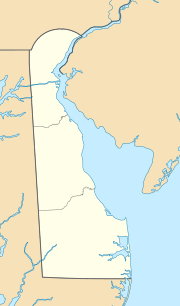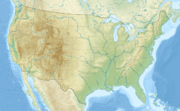Duck Creek (Smyrna River tributary) facts for kids
Quick facts for kids Duck Creek |
|
|---|---|
| Other name(s) | Tributary to Smyrna River |
| Country | United States |
| State | Delaware |
| County | New Castle Kent |
| City | Smyrna |
| Physical characteristics | |
| Main source | Duck Creek Pond at the confluence of Green Spring Branch and Providence Creek Smyrna, Delaware 10 ft (3.0 m) 39°18′28″N 075°37′22″W / 39.30778°N 75.62278°W |
| River mouth | Smyrna River about 1 mile northeast of Smyrna, Delaware 0 ft (0 m) 39°18′46″N 075°34′29″W / 39.31278°N 75.57472°W |
| Length | 3.86 mi (6.21 km) |
| Depth |
|
| Basin features | |
| Progression | east |
| River system | Smyrna River |
| Basin size | 23.13 square miles (59.9 km2) |
| Tributaries |
|
| Bridges | Duck Creek Road, US 13, DE 1, Smyrna Landing Road |
Duck Creek is a small stream, about 3.86 mi (6.21 km) long, located in New Castle County, Delaware. It flows into the Smyrna River. Think of it as a smaller stream that feeds into a larger one.
Other Names for Duck Creek
Did you know that Duck Creek has been called by different names throughout history? The Geographic Names Information System keeps track of these names. Some of the old names for Duck Creek include:
- Ancke Kijhlen
- Ende Kil
- Green Branch
- Old Duck Creek
- Quinquingo Cipus
- Smyrna River
Where Does Duck Creek Start and End?
Duck Creek begins in a place called Duck Creek Pond. This pond is formed where two smaller streams, Green Spring Branch and Providence Creek, meet up in Smyrna, Delaware.
From there, Duck Creek flows towards the east. It eventually joins with Mill Creek to form the Smyrna River. This meeting point is about 1 mile (1.6 km) northeast of Smyrna.
The Duck Creek Area
The land area that drains water into Duck Creek is called its watershed. The Duck Creek watershed covers about 23.13 square miles (59.9 km2) (59.9 km²) of land. This means all the rain and water that falls in this area will eventually flow into Duck Creek.
The area gets a good amount of rain each year, about 44.5 inches (113 cm). A small part of the watershed, about 3.4%, is covered by forests.



